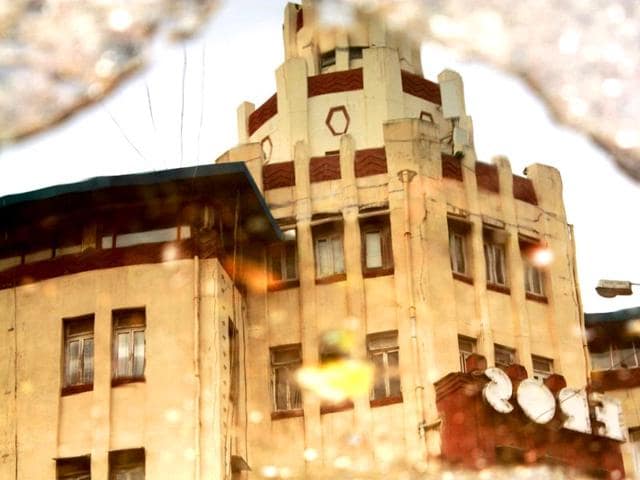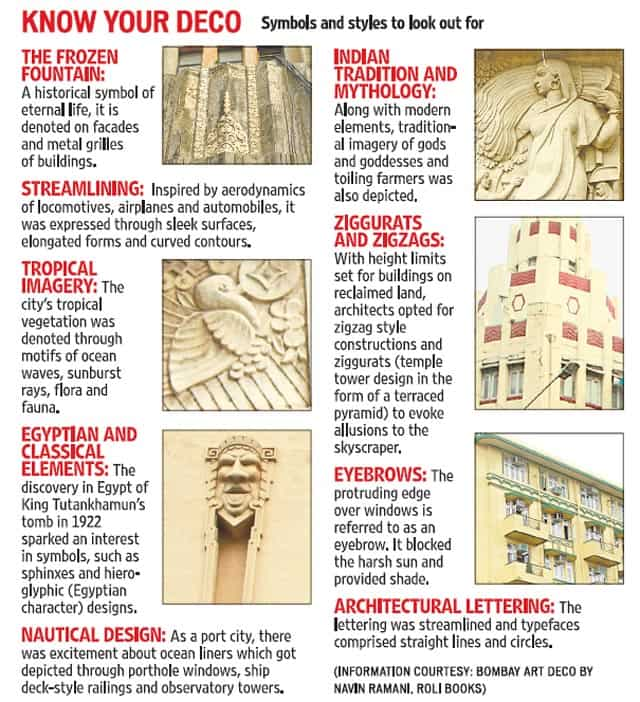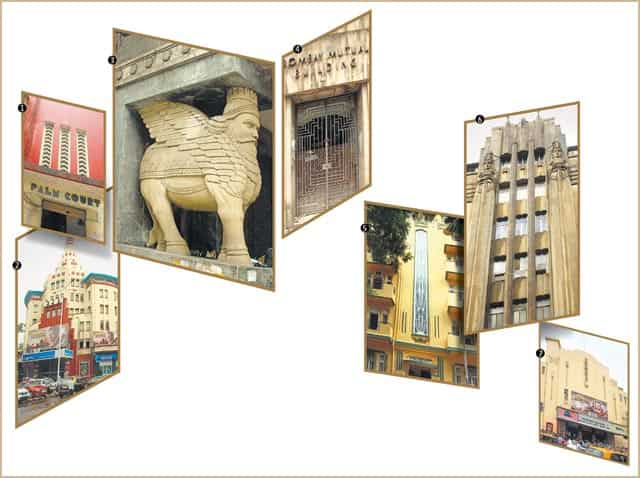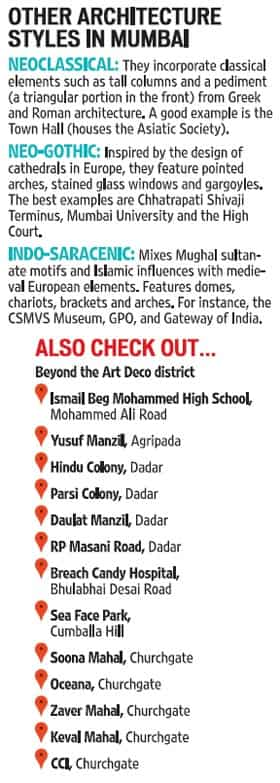Art Deco-ded: Explore south Mumbai's timeless architecture
Turrets shaped like flying saucers, nautical elements, an obsession with streamlining – Mumbai’s Art Deco structures denote a forward-thinking era and a proud city. Watch out for the geometric patterns (saucer-like turrets; zigzags), maritime elements (waves, ship deck-style railings, porthole windows), the rounded balconies, the obsession with symmetry, and you will be transported to a different era — the ‘20s to the ‘40s, to be specific.
On weekdays, the Oval Maidan and Fort areas are abuzz with work as usual. Taxis zip past, lawyers go about hurriedly in their black coats, bankers in suits emerge for lunch, and then dive right back into their busy cubicles.

But visit on a Sunday morning, and the area transforms. Wide roads turn into venues for gully cricket, with wooden chairs serving as makeshift wickets. For the shops and restaurants, it’s a lean day. And you can lazily amble through the streets, camera in hand, taking in all the magnificent architecture.
Look closely, though, and it’s evident why Mumbai prides itself on a particular style of architecture — Art Deco.
Watch out for the geometric patterns (saucer-like turrets; zigzags), maritime elements (waves, ship deck-style railings, porthole windows), the rounded balconies, the obsession with symmetry, and you will be transported to a different era — the ‘20s to the ‘40s, to be specific.
You will need to peer through the trees, ignore the air-conditioners, look past all the ugly signage and wiring, even request a guard or two to let you take a picture. But it’s a rewarding experience — whether you are a tourist, or have lived in the city all your life.
Go now (armed with an umbrella), when the cloud cover makes for cooler afternoons, and while Mumbai fights for UNESCO World Heritage Site status for this part of the city.
For more perspective, you can take a detour and head to the Sir JJ College of Architecture to view Deco on the Oval. In a bid to draw attention to Art Deco structures, architecture students, along with Professor Mustansir Dalvi (curator), are hosting an exhibition featuring drawings and vintage photographs of 18 structures near Oval Maidan, shown as they were when initially constructed.
“Mumbai has the most Art Deco buildings after Miami city. We hope the exhibition strengthens the case for Mumbai as a city worth getting heritage status,” says Dalvi.
What to see, where to see it
Most of the Art Deco structures are located in south Mumbai — the road next to Oval Maidan, on the Eros side; Sir Pherozeshah Mehta Road (PM Road), MG Road and Marine Drive. PM Road has the office buildings like United India Building and New India Assurance, while Oval Maidan is a residential stretch and includes old apartments such as Green Fields, Sunshine and Empress Court. Then, there are the Art Deco cinema houses — Eros, Regal, Metro, New Empire and Liberty.
The residential Art Deco buildings near Oval and on Marine Drive were built on reclaimed land (thanks to the Backbay Land Reclamation Scheme, 1928-1942). The initial structures set a precedent that was followed by successive constructions, and this lent this area the homogeneity and character we now see.

There are other (fewer) Art Deco structures scattered around the city, in older areas like Mohammed Ali Road, Girgaum, Dadar, Chembur and Bandra.
The easiest way to tell Art Deco is by the ornate lettering over doors and on the walls. The structures were also built using modern technology and, through the symbols, reflect the advancements of the period. Significantly, most of the structures near the Oval Maidan were built within half a decade (1935 to 1940).
What makes it Art Deco?
The architectural style emerged with a legendary 1925 exposition in Paris. It stayed in vogue, internationally, from the 1920s to the 1940s. The term ‘Art Deco’, however, was coined much later, in the 1960s, as an abbreviation of the French term ‘Arts Decoratifs’.
The structures in Mumbai had global influences — from Egypt and Persia, among others. “With the discovery of Tutankhamun’s tomb in the late ’20s, the aesthetic was reflected in the architecture,” says Dalvi.
Most of the buildings, however, were designed by Indian architects, most of them graduates of JJ College.
They kept the city’s climate in mind, factoring in the heavy monsoon and the heat (hence, the deep balconies and awnings). Indian symbolism found its way with elements like the Lakshmi statue, lotuses, and elephant motifs on the Lakshmi Insurance Building; and murals of farmers and women in saris on The New India Assurance Building. The phenomenon continued till the ’50s, with Liberty Cinema among the last few buildings in Art Deco style.
While the British-era Gothic structures were symbols of the empire, as were all public buildings, Art Deco structures were more indigenous and reflected the local urbanisation and international outlook. “It reflects a flourishing age. These were an early type of apartment where the residents were aware of global trends, and eager to adopt them. Foreigners and rulers of princely states also lived in such houses,” says Dalvi. The prominent Deco architects, like GB Mhatre, also consciously moved away from the colonial style of architecture.

1. Palm Court has a chevron (V-shaped) motif
2. Eros Cinema has a cylindrical tower
3. Winged mythological figures frame the portal of the Bai Pirojbai Dadabhoy Maneckji Vatcha Agiary
4. The Bombay Mutual Building has streamlined lettering
5. Shiv Shanti Bhuvan has a soaring glass panel with a sunburst motif
6. New India Assurance Building has a monolithic stone relief with Egyptian and Classical themes
7. Regal Cinema’s facade has a stepped-up parapet
The fight for heritage status
In his 2007 book, Bombay Art Deco Architecture, Navin Ramani, who grew up in Court View, compares Mumbai’s structures with the architecture on Miami Beach’s Art Deco District in USA. He rues the current state of the buildings in the city, though: “Many of Mumbai’s Art Deco buildings suffer from poor maintenance and insensitive renovations that ruin the original design. The Rent Control Act and limited financial resources are also cited by the landlords for the lack of upkeep.”
With little by the way of conservation efforts, many structures are losing their battle to time. Several such buildings in Dadar are already going for redevelopment. To ensure the remaining ones, are maintained properly, citizen groups and the likes of Abha Narain Lambah (conservation architect) and Nayana Kathpalia, member of the Oval Trust, have been campaigning for UNESCO World Heritage Status for the structures along Oval.
In 2012, Lambah filed a nomination dossier – a detailed documentation that was submitted to the Maharashtra government, and sent to Delhi, to be sent to UNESCO. While it lost out its nomination to Delhi that year, this year, Nalanda got nominated. The architect is hoping for a nomination for the next slot: January 31, 2016.
“It took nine years to get an official endorsement. The dossier is a painstaking process; it requires the place to be mapped and its outstanding value recorded,” Lambah explains. The Mumbai campaign was funded completely by the citizens, who managed to raise `15 lakh by themselves.
With the Heritage Review Committee deciding, in April this year, to retain Marine Drive’s sea-facing stretch on the heritage list, Lambah and the residents are hopeful that the overall management of the area will improve and that the heritage status might soon materialise.
'Deco on the oval' is on till August 15, 10.30am to 5pm (except Sundays), at The Claude Batley Gallery, Sir JJ College of Architecture, DN Road.
Art Deco in the spotlight
Deco on the Oval, an ongoing exhibition at Sir JJ College of Architecture, showcases Art Deco structures around Oval Maidan. A group of third and fourth year architecture students worked for a year on the project. For reference, they used older drawings (dating back to 1996) and contemporary images, to redraw the facades as they were originally built. “We went over the early documentation and made ‘restored drawings’. It was tough as some of the structures have had many alterations over the years,” says Aakriti Chandervanshi, a fourth-year student.






